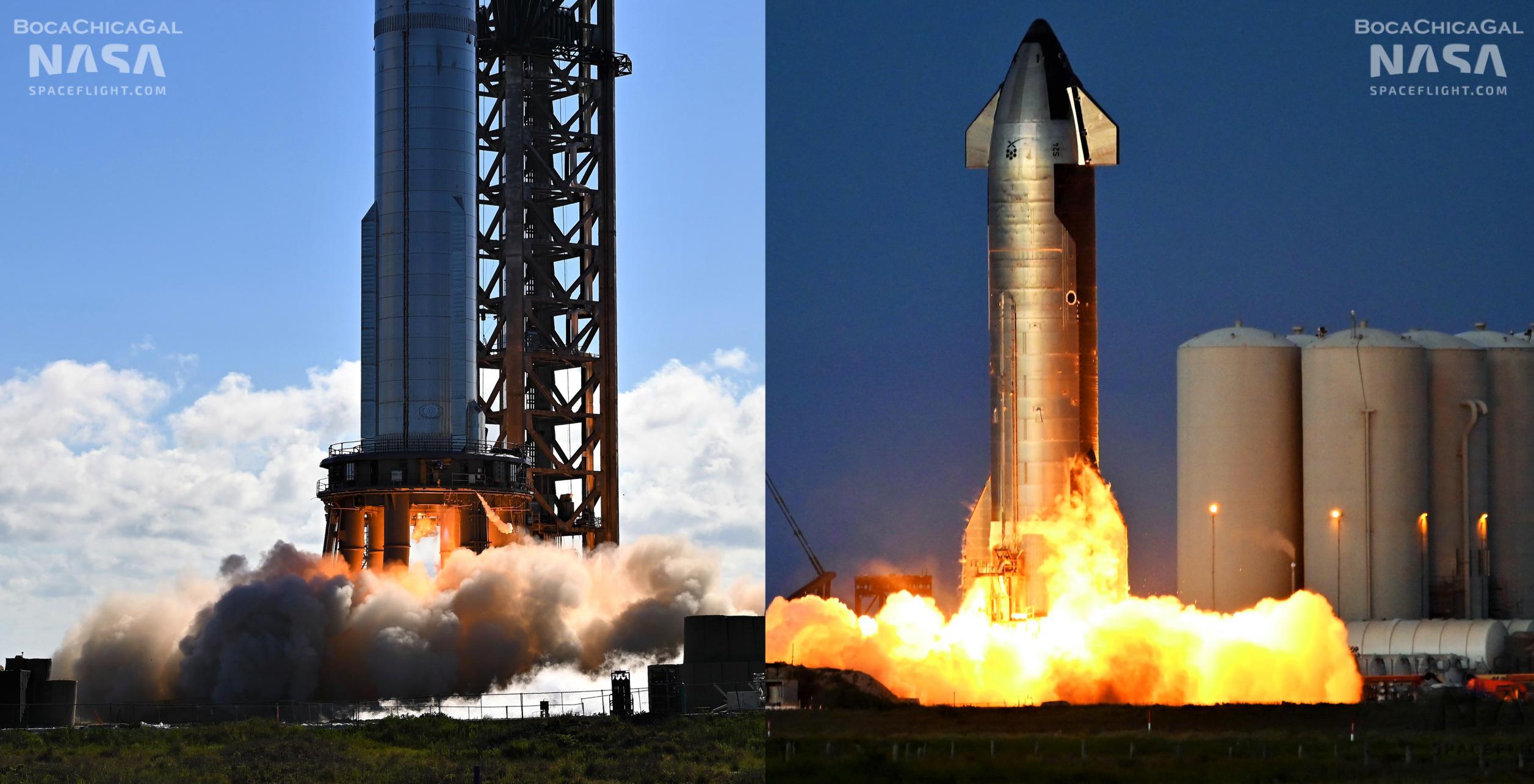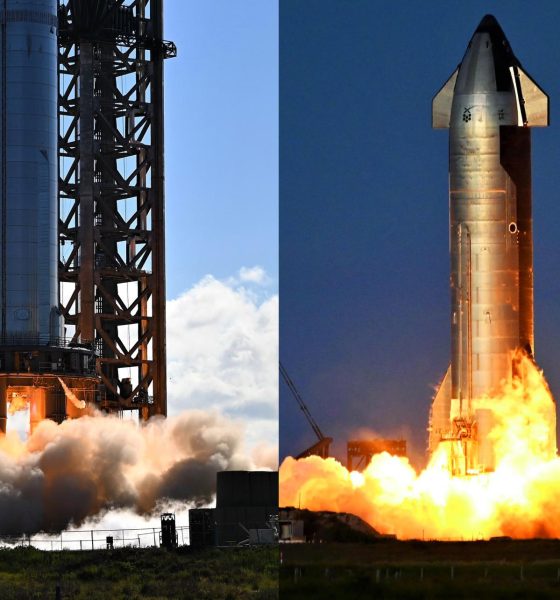

News
SpaceX fires up Starship and Super Heavy booster hours apart
SpaceX appears to have successfully fired up a Starship and Super Heavy booster hours apart, testing a total of three new Raptor 2 engines on the two rockets.
SpaceX says it completed a two-engine static fire with Starship 24 less than three hours after the company successfully ignited a Raptor 2 engine installed on a rocket prototype for the first time. That earlier test, performed by Super Heavy Booster 7, was also the first time SpaceX used its new Starbase orbital launch site to support a static fire test and the second-ever static fire of a Starship booster prototype. Had the company called it quits after Booster 7 survived its first intentional trial by fire, it would have still been an exceptionally successful day.
But SpaceX wasn’t done.
Instead, after Booster 7’s seemingly flawless single-Raptor static fire at 5:25 pm CDT, SpaceX loaded Starship 24 with a small amount of liquid oxygen and methane propellant and ignited two of the ship’s six engines around 8:18 pm. It was not initially clear how many engines were involved but a tweet from SpaceX later confirmed it was two. More likely than not, one of those engines was a sea level-optimized Raptor with a smaller bell nozzle and the other was a vacuum-optimized Raptor with a much larger nozzle.
Almost ten months ago, Starship 20 – SpaceX’s first potentially orbital-class Starship prototype – began static fire testing in a somewhat similar way. Its first day of static fires began with a single Raptor Vacuum engine and ended with a simultaneous RVac and sea-level Raptor test in October 2021. In some ways, SpaceX has been a bit less cautious with Starship 24, which is the second potentially orbital-class prototype to begin proof testing. Ship 24 already has all six Raptors installed, whereas Ship 20 only had four of six engines installed during its first static fire tests. SpaceX also took about three weeks to progress from Ship 20’s first static fire test to its first static fire of all six engines, whereas it appears that Ship 24 could potentially attempt its first six-engine test just a few days to a week later.
On the other hand, Ship 24’s path to its first static fire was substantially longer than Ship 20’s. Ship 20 completed its first static fire test(s) just 25 days after its first proof test, referring to the process of verifying that the prototype was in good working order before moving on to riskier testing with flammable propellant and intentional ignitions. Ship 20 also completed its first six-engine static fire 46 days after testing began. Ship 24, meanwhile, took 75 days to go from its first proof test to its first static fire – almost three times slower than Ship 20, a prototype that was essentially the first of its kind.
It’s possible that Ship 24’s upgraded Raptor 2 engines are partially or fully to blame. Instead of jumping straight into ‘hot’ Raptor testing like Ship 20, which began that particular campaign with a partial-ignition preburner test, SpaceX put Ship 24 through seven ‘spin-prime’ tests before its first static fire. For Raptor, spin-primes test the ignition step before preburner ignition, which is itself a step before main combustion chamber ignition (where the engine starts to produce meaningful thrust). Raptor startup procedures likely involve flowing high-pressure gaseous helium, nitrogen, or propellant (oxygen/methane) through the engine to spin up its turbopumps, ‘priming’ them for preburner and main combustion chamber ignition.
On Raptor 1, the preburners would ignite once a high enough flow rate was achieved, producing hot gas that the main combustion chamber would mix and ignite one last time to start the engine. In a recent interview with Tim Dodd (“The Everyday Astronaut”), CEO Elon Musk revealed that SpaceX was able to “remove torch igniters” from Raptor 2’s main combustion chamber (MCC). It’s unclear if that means that Raptor 2 now has zero MCC igniters, but a major change in the overall ignition process could explain why the start of Ship 24 and Booster 7 engine testing was so sluggish. So could the unintended explosion Booster 7 caused when SpaceX attempted to spin-prime all 33 of its Raptor 2 engines at once.
Regardless, SpaceX has finally crossed that particular Rubicon and, with any luck, Raptor 2 testing will begin to speed up on both Starship 24 and Super Heavy Booster 7. SpaceX has test windows scheduled on August 11th, 15th, and 16th. A warning distributed to Boca Chica, Texas residents on August 10th confirmed that the company intends to perform at least one more static fire test on the 11th.

News
Tesla FSD V14.2.1 is earning rave reviews from users in diverse conditions
Tesla’s Full Self-Driving (Supervised) software continues its rapid evolution, with the latest V14.2.1 update drawing widespread praise.

Tesla’s Full Self-Driving (Supervised) software continues its rapid evolution, with the latest V14.2.1 update drawing widespread praise for its smoother performance and smarter decision-making.
Videos and firsthand accounts from Tesla owners highlight V14.2.1 as an update that improves navigation responsiveness, sign recognition, and overall fluidity, among other things. Some drivers have even described it as “more alive than ever,” hinting at the system eventually feeling “sentient,” as Elon Musk has predicted.
FSD V14.2.1 first impressions
Early adopters are buzzing about how V14.2.1 feels less intrusive while staying vigilant. In a post shared on X, Tesla owner @LactoseLunatic described the update as a “huge leap forward,” adding that the system remains “incredibly assertive but still safe.”
Another Tesla driver, Devin Olsenn, who logged ~600 km on V14.2.1, reported no safety disengagements, with the car feeling “more alive than ever.” The Tesla owner noted that his wife now defaults to using FSD V14, as the system is already very smooth and refined.
Adverse weather and regulatory zones are testing grounds where V14.2.1 shines, at least according to testers in snow areas. Tesla watcher Sawyer Merritt shared a video of his first snowy drive on unplowed rural roads in New Hampshire, where FSD did great and erred on the side of caution. As per Merritt, FSD V14.2.1 was “extra cautious” but it performed well overall.
Sign recognition and freeway prowess
Sign recognition also seemed to show improvements with FSD V14.2.1. Longtime FSD tester Chuck Cook highlighted a clip from his upcoming first-impressions video, showcasing improved school zone behavior. “I think it read the signs better,” he observed, though in standard mode, it didn’t fully drop to 15 mph within the short timeframe. This nuance points to V14.2.1’s growing awareness of temporal rules, a step toward fewer false positives in dynamic environments.
FSD V14.2.1 also seems to excel in high-stress highway scenarios. Fellow FSD tester @BLKMDL3 posted a video of FSD V14.2.1 managing a multi-lane freeway closure due to a police chase-related accident. “Perfectly handles all lanes of the freeway merging into one,” the Tesla owner noted in his post on X.
FSD V14.2.1 was released on Thanksgiving, much to the pleasant surprise of Tesla owners. The update’s release notes are almost identical to the system’s previous iteration, save for one line item read, “Camera visibility can lead to increased attention monitoring sensitivity.”
News
Tesla FSD Supervised ride-alongs in Europe begin in Italy, France, and Germany
The program allows the public to hop in as a non-driving observer to witness FSD navigate urban streets firsthand.

Tesla has kicked off passenger ride-alongs for Full Self-Driving (Supervised) in Italy, France and Germany. The program allows the public to hop in as a non-driving observer to witness FSD navigate urban streets firsthand.
The program, detailed on Tesla’s event pages, arrives ahead of a potential early 2026 Dutch regulatory approval that could unlock a potential EU-wide rollout for FSD.
Hands-Off Demos
Tesla’s ride-along invites participants to “ride along in the passenger seat to experience how it handles real-world traffic & the most stressful parts of daily driving, making the roads safer for all,” as per the company’s announcement on X through its official Tesla Europe & Middle East account.
Sign-ups via localized pages offer free slots through December, with Tesla teams piloting vehicles through city streets, roundabouts and highways.
“Be one of the first to experience Full Self-Driving (Supervised) from the passenger seat. Our team will take you along as a passenger and show you how Full Self-Driving (Supervised) works under real-world road conditions,” Tesla wrote. “Discover how it reacts to live traffic and masters the most stressful parts of driving to make the roads safer for you and others. Come join us to learn how we are moving closer to a fully autonomous future.”
Building trust towards an FSD Unsupervised rollout
Tesla’s FSD (Supervised) ride-alongs could be an effective tool to build trust and get regular car buyers and commuters used to the idea of vehicles driving themselves. By seating riders shotgun, Tesla could provide participants with a front row seat to the bleeding edge of consumer-grade driverless systems.
FSD (Supervised) has already been rolled out to several countries, such as the United States, Canada, Australia, New Zealand, and partially in China. So far, FSD (Supervised) has been received positively by drivers, as it really makes driving tasks and long trips significantly easier and more pleasant.
FSD is a key safety feature as well, which became all too evident when a Tesla driving on FSD was hit by what seemed to be a meteorite in Australia. The vehicle moved safely despite the impact, though the same would likely not be true had the car been driven manually.
News
Swedish union rep pissed that Tesla is working around a postal blockade they started
Tesla Sweden is now using dozens of private residences as a way to obtain license plates for its vehicles.

Two years into their postal blockade, Swedish unions are outraged that Tesla is still able to provide its customers’ vehicles with valid plates through various clever workarounds.
Seko chairman Gabriella Lavecchia called it “embarrassing” that the world’s largest EV maker, owned by CEO Elon Musk, refuses to simply roll over and accept the unions’ demands.
Unions shocked Tesla won’t just roll over and surrender
The postal unions’ blockade began in November 2023 when Seko and IF Metall-linked unions stopped all mail to Tesla sites to force a collective agreement. License plates for Tesla vehicles instantly became the perfect pressure point, as noted in a Dagens Arbete report.
Tesla responded by implementing initiatives to work around the blockades. A recent investigation from Arbetet revealed that Tesla Sweden is now using dozens of private residences, including one employee’s parents’ house in Trångsund and a customer-relations staffer’s home in Vårby, as a way to obtain license plates for its vehicles.
Seko chairman Gabriella Lavecchia is not pleased that Tesla Sweden is working around the unions’ efforts yet again. “It is embarrassing that one of the world’s largest car companies, owned by one of the world’s richest people, has sunk this low,” she told the outlet. “Unfortunately, it is completely frivolous that such a large company conducts business in this way.”
Two years on and plates are still being received
The Swedish Transport Agency has confirmed Tesla is still using several different workarounds to overcome the unions’ blockades.
As noted by DA, Tesla Sweden previously used different addresses to receive its license plates. At one point, the electric vehicle maker used addresses for car care shops. Tesla Sweden reportedly used this strategy in Östermalm in Stockholm, as well as in Norrköping and Gothenburg.
Another strategy that Tesla Sweden reportedly implemented involved replacement plates being ordered by private individuals when vehicles change hands from Tesla to car buyers. There have also been cases where the police have reportedly issued temporary plates to Tesla vehicles.









